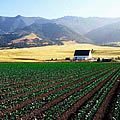On Location in Salinas Valley, California

"I want to describe the Salinas Valley in detail but in sparse detail so that there can be a real feeling of it. It should be sights and sounds, smells and colors but put down with simplicity as though the boys [his sons] were able to read it. This is the physical background of the book." — John Steinbeck, Journal of a Novel: The East of Eden Letters
Boyhood LandJohn Steinbeck is, at heart, a novelist of the California experience. Born in Salinas, California and grew up in the fertile Salinas Valley, the "Salad Bowl of the Nation," as it was later called. Steinbeck spent hours as a boy roaming the hills—the sharply beautiful and expansive landscape shaped his creative vision. Steinbeck's California fiction envisions the dreams and defeats of common people as shaped by the magnificent land they inhabit. Explore a map of the locations of come of his California novels.
An Autobiography of Salinas Valley
Steinbeck called East of Eden "a sort of autobiography of the Salinas Valley." Early in the writing process, he considered both "My Valley" and "The Salinas Valley" as possible titles for his novel. For, as he wrote in Journal of a Novel: The East of Eden Letters, his book would be "the story of my country and the story of me." He was careful not to rely on dim recollections of his past; he thoroughly researched the place of his origins. He wanted to get the geography, animal and plant life, rhythms of nature and history just right: the Salinas Valley would serve as a microcosm of the world where the major theme of his book would be enacted.
Thematic Tensions in the Setting
Steinbeck often opens books and stories with a description of the land, of place. These descriptions are not merely a backdrop to the action. They are rich with thematic associations. In East of Eden, for example, the land is described as a place of sharp contrasts. These oppositions underlie the central clash in the novel, between what we see as good and as evil. The oppositions suggested in the opening chapter establish the complex mood of the valley: the land is both inviting and unfriendly; light and dark; safe and dangerous. Other oppositions are night and day; birth and death; love and dread.The river of life, in which the struggle between good and evil takes place, runs between these opposing forces.
A New Eden?
Note that, in moving to Salinas, the characters—the Hamiltons and Adam Trask—have traveled west, which, in American literature, is generally associated with the search for a new Eden. But here, the "west" is both full of promise and described as ominous. The characters' idealism is bound to meet with trouble.
Source:
- Journal of a Novel: The East of Eden Letters by John Steinbeck (The Viking Press, Inc.,1969; Penguin Books, 1990)
- sjsu.edu



